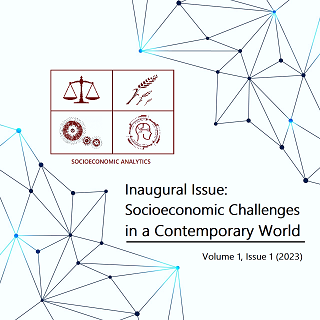Application of the Beta Distribution Model to the Customer Churn Rate
DOI:
https://doi.org/10.51359/2965-4661.2023.259280Keywords:
Beta Distribution, Costumer Churn Rate, ; Maximum Likelihood Estimation, Ox, RAbstract
The beta distribution model has been applied in many different research environments due to the flexibility of its two parameters. In this research, we fit this probabilistic model for mod- eling a recurring problem confronted for many businesses called the customer churn rate (or churn rate). It represents the proportion of customers who cancel their subscriptions after a given time. We use data from a Brazilian media service company to develop the modeling. The parameters are estimated by the maximum likelihood estimation (MLE) technique. Finally, we perform the MLE technique by considering two programming languages; Ox and R.
References
R. Axelsson and A. Nostam. Identify churn a study in how transaction data can be used to identify churn for merchants. Master’s thesis, KTH, School of Industrial Engineering and Management (ITM), 2017.
P. Bhunya, S. Mishra, C. Ojha, and R. Berndtsson. Parameter estimation of beta distribution for unit hydrograph derivation. Journal of Hydrologic Engineering, 9(4):325–332, 2004. doi: 10.1061/(ASCE)1084-0699(2004)9:4(325).
H. Bierman-Jr and W. H. Hausman. The credit granting decision. Management Science, 16(8): B519 – B532, 1970.
J. Burez and D. Van den Poel. Crm at a pay-tv company: Using analytical models to reduce customer attrition by targeted marketing for subscription services. Expert Systems with Applications, 32(2):277 – 288, 2007. doi: https://doi.org/10.1016/j.eswa.2005.11.037.
G. Casella and R. Berger. Statistical Inference, volume 2. Duxbury Pacific Grove, California, 2002.
E. Chia and M. Hutchinson. The beta distribution as a probability model for daily cloud duration. Agricultural and Forest Meteorology, 56(3):195 – 208, 1991. doi: https://doi.org/10.1016/ 0168-1923(91)90091-4.
F. Cribari-Neto and S. G. Zarkos. Econometric and statistical computing using ox. Computational Economics, 21(3):277–295, 2003. doi: https://doi.org/10.1023/A:1023902027800.
B. Efron and R. Tibshirani. Bootstrap methods for standard errors, confidence intervals, and other measures of statistical accuracy. Statistical Science, 1(1):54–75, 1986. doi: 10.1214/ss/ 1177013815.
P. Fader and B. Hardie. How to project customer retention. Journal of Interactive Marketing, 21 (1):76 – 90, 2007. doi: https://doi.org/10.1002/dir.20074.
S. Ferrari and F. Cribari-Neto. Beta regression for modelling rates and proportions. Journal of Applied Statistics, 31(7):799–815, 2004. doi: 10.1080/0266476042000214501.
C. Gauss and F. Cribari-Neto. An Introduction to Bartlett Correction and Bias Reduction, vol- ume 1. Springer Berlin Heidelberg, Berlin, Heidelberg, 2014. doi: https://doi.org/10.1007/ 978-3-642-55255-7 1.
D. Golenko-Ginzburg. On the distribution of activity time in pert. The Journal of the Operational Research Society, 39(8):767–771, 1988. doi: https://doi.org/10.1057/jors.1988.132.
A. Gupta and S. Nadarajah. Handbook of Beta Distribution and Its Applications. CRC Press, Boca Raton, 2004. doi: https://doi.org/10.1201/9781482276596.
J. Hadden, A. Tiwari, R. Roy, and D. Ruta. Computer assisted customer churn management: State-of-the-art and future trends. Computers & Operations Research, 34(10):2902 – 2917, 2007. doi: https://doi.org/10.1016/j.cor.2005.11.007.
M. Hajdu and O. Bokor. The effects of different activity distributions on project duration in pert networks. Procedia - Social and Behavioral Sciences, 119:766 – 775, 2014. doi: https:
//doi.org/10.1016/j.sbspro.2014.03.086.
S. Hoppner, E. Stripling, B. Baesens, S. vanden Broucke, and T. Verdonck. Profit driven decision trees for churn prediction. European Journal of Operational Research, 284(3):920 – 933, 2020. doi: https://doi.org/10.1016/j.ejor.2018.11.072.
Y. Hung, N. Balakrishnan, and Y. Lin. Evaluation of beta generation algorithms. Communications in Statistics - Simulation and Computation, 38(4):750–770, 2009. doi: https://doi.org/10.1080/ 03610910802645347.
H. Hwang, T. Jung, and E. Suh. An ltv model and customer segmentation based on customer value: a case study on the wireless telecommunication industry. Expert Systems with Applications, 26 (2):181 – 188, 2004. doi: https://doi.org/10.1016/S0957-4174(03)00133-7.
K. Jung, J. Shin, and D. Park. A new approach for river network classification based on the beta distribution of tributary junction angles. Journal of Hydrology, 572:66 – 74, 2019. doi: https://doi.org/10.1016/j.jhydrol.2019.02.041.
K. Krishnamoorthy. Handbook of statistical distributions with applications. CRC Press, New York, 2016. doi: https://doi.org/10.1201/b19191.
D. Lallemant and A. Kiremidjian. A beta distribution model for characterizing earthquake damage state distribution. Earthquake Spectra, 31(3):1337–1352, 2015. doi: https://doi.org/10.1193/ 012413EQS013M.
D. G. Malcolm, J. Roseboom, C. E. Clark, and W. Fazar. Application of a technique for research and development program evaluation. Operations Research, 7(5):646–669, 1959. doi: https:
//doi.org/10.1287/opre.7.5.646.
J. Nocedal and S. Wright. Numerical Optimization, volume 1. Springer New York, New York, NY, 2006. doi: https://doi.org/10.1007/978-0-387-40065-5.
D. Oguamanam, H. Martin, and J. Huissoon. On the application of the beta distribution to gear damage analysis. Applied Acoustics, 45(3):247 – 261, 1995.
C. Owen. Parameter estimation for the beta distribution. Master’s thesis, Statistics Department, 2008.
Y. Pawitan. In all likelihood: statistical modelling and inference using likelihood, volume 1. Oxford University Press, Oxford, 2001.
J. M. Podivinsky. Ox 2.10: beast of burden or object of desire? Journal of Economic Surveys, 13 (4):491–502, 1999. doi: doi:10.1111/1467-6419.00094.
I. Seo and K. O. Baek. Estimation of the longitudinal dispersion coefficient using the velocity profile in natural streams. Journal of Hydraulic Engineering, 130(3):227–236, 2004. doi: 10. 1061/(ASCE)0733-9429(2004)130:3(227).
M. Sulaiman, W. Hlaing Oo, M. Abd Wahab, and A. Zakaria. Application of beta distribution model to malaysian sunshine data. Renewable Energy, 18(4):573 – 579, 1999. doi: https:
//doi.org/10.1016/S0960-1481(99)00002-6.
T. Vafeiadis, K. Diamantaras, G. Sarigiannidis, and K. Chatzisavvas. A comparison of machine learning techniques for customer churn prediction. Simulation Modelling Practice and Theory, 55:1 – 9, 2015. doi: https://doi.org/10.1016/j.simpat.2015.03.003.
W. Venables and B. Ripley. Modern Applied Statistics with S, volume 1. Springer New York, New York, NY, 4 edition, 2002. doi: 10.1007/978-0-387-21706-2 1.
H. Yeon and L. Sehun. Customer churning prediction using support vector machines in online auto insurance service. In Advances in Neural Networks – ISNN 2005, pages 928–933, Berlin, Heidelberg, 2005. Springer Berlin Heidelberg. doi: https://doi.org/10.1007/11427445 149.
Downloads
Additional Files
Published
Issue
Section
License
Copyright (c) 2023 Henrique Pinto dos Santos Zaidan

This work is licensed under a Creative Commons Attribution-NonCommercial-NoDerivatives 4.0 International License.
Authors who publish with Socioeconomic Analytics retain the copyright of their work and agree to license it under a Creative Commons Attribution-NonCommercial-NoDerivatives 4.0 International (CC BY-NC-ND 4.0) license. This means that the work can be shared, copied, and redistributed in any medium or format, as long as it is not used for commercial purposes, and the original work is properly cited. The work cannot be changed in any way or used to create derivative works.










